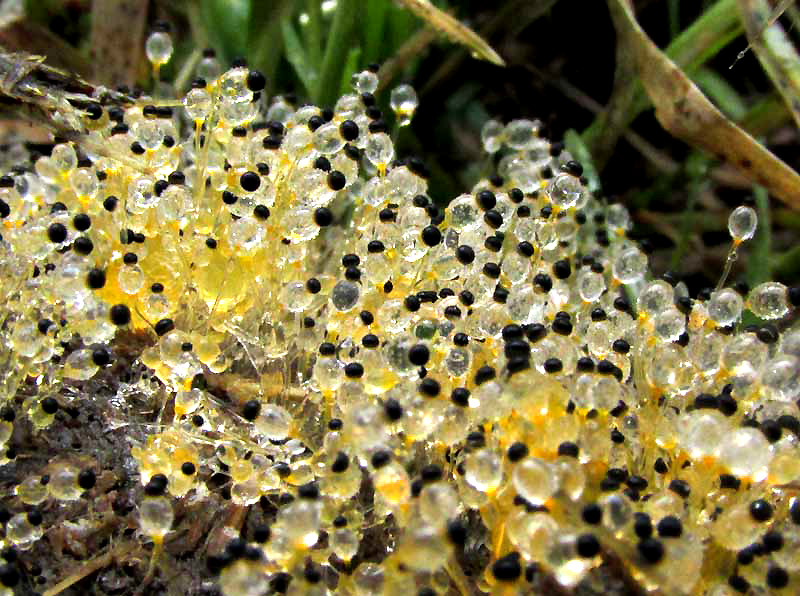Excerpts from Jim Conrad's
Naturalist Newsletter
from the October 22, 2017 Newsletter, a special on-the-road edition with notes from near Tepotzlán, Morelos state, MÉXICO, elevation about 5315 ft (1620m), at 18°59′07″N 99°05′59″W
SLIME MOLD ON HORSE MANURE
Early the first morning of my recent week-long visit with a friend near Tepotzlán, Morelos in high-elevation south-central Mexico, we went walking in his orchard so I could admire his plantings. I might have disappointed my friend when my very first show of excitement wasn't one of his wonderful trees, but rather a pile of horse manure. It was thickly covered with tiny translucent globes held atop hairlike stalks, each globe topped with an even smaller black sphere, as shown below:

A closer-up view better showing the very slender, transparent stalks, the dewy, glass-ball-like globes, and the black spheres atop the globes is shown below:

These are slime mold fruiting bodies. Slime molds are one of the most mysterious and interesting of all kinds of living things, not animals, not plants, not fungi, but something else entirely. They're Amoebozoa living by their own rules.
I have no idea what kind of slime mold we have here*, but it's clear that we're seeing a good example of the "stalk phase" of the species. Here's how the stalk phase fits into a typical slime mold's life cycle:
First you have a single cell, a kind of amoeba, prowling about searching for bacteria, which it takes into its body, and digests. A well fed amoeba divides in two, and those two cells further feed and eventually divide, on and on, until some kind of hard time comes for the colony. Maybe the bacterial food runs out, things dry out, or temperature goes out of whack.
When this happens, the individual slime mold cells, the amoebas, start migrating to a certain point where they join with their neighbors, maybe a million of them, all converging and merging into one another to form a swirling mound.
Now the mound begins behaving as if it were a single organism. It forms something like a bullet-shaped slug the size of a sand grain, slithers to someplace that feels right, and after several hours the slug turns into a blob.
Then the blob starts forming a slender stalk, atop which a globe is formed. That's what we're seeing in our photos, though our species produces smaller, black globes atop the transparent ones, and I just don't know how to interpret that. It must be a special feature of this slime mold species. The globes atop regular slime mold stalks contain amoebas left over from the stalk-forming process, and these globe amoebaes form dormant spores. The spores await some kind of event that will splash, knock or carry them to a new bacteria-rich location where they can start the life cycle over again.
One of the most interesting features of the above scenario is that the amoebas forming the stalks die. Evolutionary scientists wonder how any species can evolve in which part of the population must commit suicide in order to help others of the community reach the spore-producing stage.
Online, you can watch a video entitled Watch Slime Molds Creep and Crawl Like Alien Slugs, produced by Princeton's John Bonner.
Wikipedia's Slime Mold Page provides a good overview of the whole, mysterious slime-mold world.